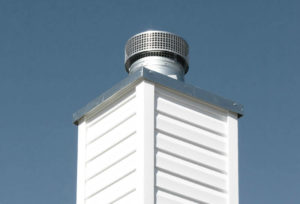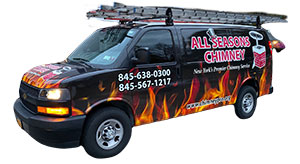Do you have a prefabricated, or factory-built chimney? If so, you may already know the answer to the question: “What is a chase cover?” However, if you just moved into a home with a prefab fireplace and chimney system, you may be unfamiliar. According to the Chimney Safety Institute of America (CSIA), most prefab chimneys are made of metal. So, the pipes that extend from the roof are typically covered with a chase, which is a structure that resembles a traditional chimney. To protect the chase from water penetration, it needs a cover. All Seasons Chimney provides customized chimney chase construction services to the residents of the lower Hudson Valley area. We would like to tell you more about this important component of a prefabricated chimney system.
 What exactly is a chase cover?
What exactly is a chase cover?
A chase cover is very similar to a chimney cap. It sits on the top of a prefabricated chimney to keep water from rain, snow, and ice as well as leaves and other debris from getting into the flue and your home. Chimney chase covers also prevent wild animals like squirrels, raccoons, and birds from entering the chimney to nest. You can also avoid the risk of accidental roof and brush fires with a chase cover. This is because it will keep hot sparks and embers from jumping out of the top of the chimney. All Seasons Chimney uses high-quality stainless steel and copper to make customized chimney chase covers. These are durable enough to last for a lifetime.
Why is it so important to have a professional install my chase cover?
In order to properly prevent water penetration damage, chimney chase covers need to be installed professionally. This ensures water will run off. If someone installs it so that the chase cover is flat, water will accumulate and pool on top of the cover. This leads to accelerated corrosion, which can crack the cover. You can trust All Seasons Chimney correctly install your chase cover. In addition, to also construct the cover so that it is angled properly in the right areas. This allows water to run off of the cover and away from your chimney. We will also build a storm collar for your prefabricated chimney system. This will give the chimney chase even more protection against water penetration.
Prolong the life of your prefabricated chimney! Contact us at All Seasons Chimney to schedule an appointment for our professional chimney chase cover construction services.


 Wood stoves are becoming a more popular choice as a energy efficient way to heat homes. According to SF Gate, the US Environmental Protection Agency (EPA) reports that over 12 million American households use
Wood stoves are becoming a more popular choice as a energy efficient way to heat homes. According to SF Gate, the US Environmental Protection Agency (EPA) reports that over 12 million American households use